Experimental principle of colorimeter
Colorimeter is a kind of instrument used to measure the color difference of objects. Its experimental principle is mainly based on the basic principle of human eye perception of color and colorimetry.

The following is the main experimental principle of the colorimeter:
Chroma space: Colorimeters use chroma space to describe colors. Commonly used chromaticity Spaces include CIE Lab color space and CIE LCh color space. In these Spaces, color is represented by three coordinates, namely brightness (L*), the red-green axis (a or C), and the yellow-blue axis (b or h).
Standard light source: The colorimeter uses a standard light source to illuminate the sample and collects the reflected light for measurement. Commonly used standard light sources include the D65 light source, which has a balanced spectral distribution similar to natural light.
Measuring sample: The sample is placed in the measuring area of the colorimeter and receives the reflected light after being irradiated by the standard light source. The color of the sample is determined by measuring the spectral distribution and intensity of the reflected light.
Experimental principle of colorimeter
Photoelectric sensor: The colorimeter uses a photoelectric sensor to measure the light reflected by the sample. Photoelectric sensors can convert light in different wavelength ranges into electrical signals.
Comparison and calculation: The colorimeter compares the measured sample color with the reference color. By calculating the difference between the sample coordinates and the reference coordinates, the color difference value of the sample is obtained. Common color difference calculation methods include ΔEab and ΔE94, which are used to represent the color difference between the sample and the reference.
According to the above experimental principle, the colorimeter can measure the color of the sample quickly and accurately, and provide the color difference value to describe the color difference between the sample and the reference. This has important applications in quality control, color matching and brand standardization in various fields.
